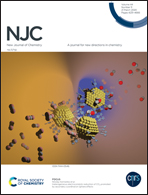Controllable photodeposition of nickel phosphide cocatalysts on cadmium sulfide nanosheets for enhanced photocatalytic hydrogen evolution performance†
Abstract
Transition metal phosphides are efficient cocatalysts in photocatalytic water splitting processes, but these phosphides are usually synthesized through harsh and tedious processes, therefore, achieving a simple, controllable and in situ loading on the photocatalyst surface is especially valuable. In this paper, two-dimensional CdS nanosheets were prepared using a hydrothermal method, followed by in situ loading of nickel phosphide (NiPx) nanoparticles on their surface by a photochemical reduction method, and NiPx loading amounts could be adjusted just by the photodeposition time. The synthesized CdS–NiPx was characterized by scanning electron microscopy, transmission electron microscopy, X-ray photoelectron spectroscopy, X-ray diffractometer, fluorescence spectroscopy and so on. CdS–NiPx exhibited better photocatalytic performances than bare CdS, and the optimal hydrogen evolution rate of 28.7 mmol g−1 h−1 was realized for CdS–NiPx with a photoreduction time of 20 min. The enhancement mechanism of their photocatalytic activity was estimated by comparing the photoluminescence spectra, electrochemical impedance spectra and transient photocurrent spectra of CdS–NiPx and CdS, which indicated that photodeposited NiPx could serve as excellent cocatalysts to efficiently suppress the recombination of electron–hole pairs photogenerated in CdS.



 Please wait while we load your content...
Please wait while we load your content...